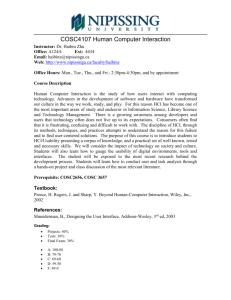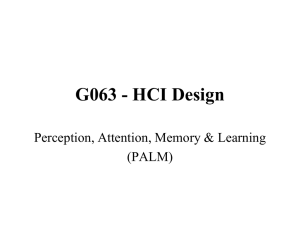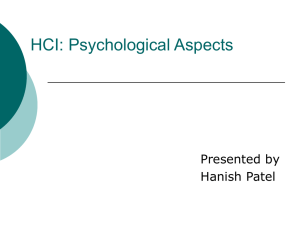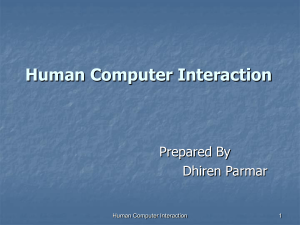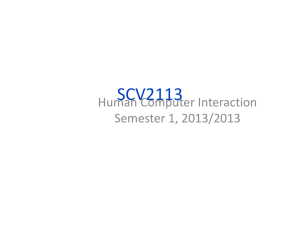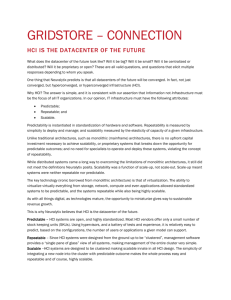Introduction - Microsoft Research
advertisement
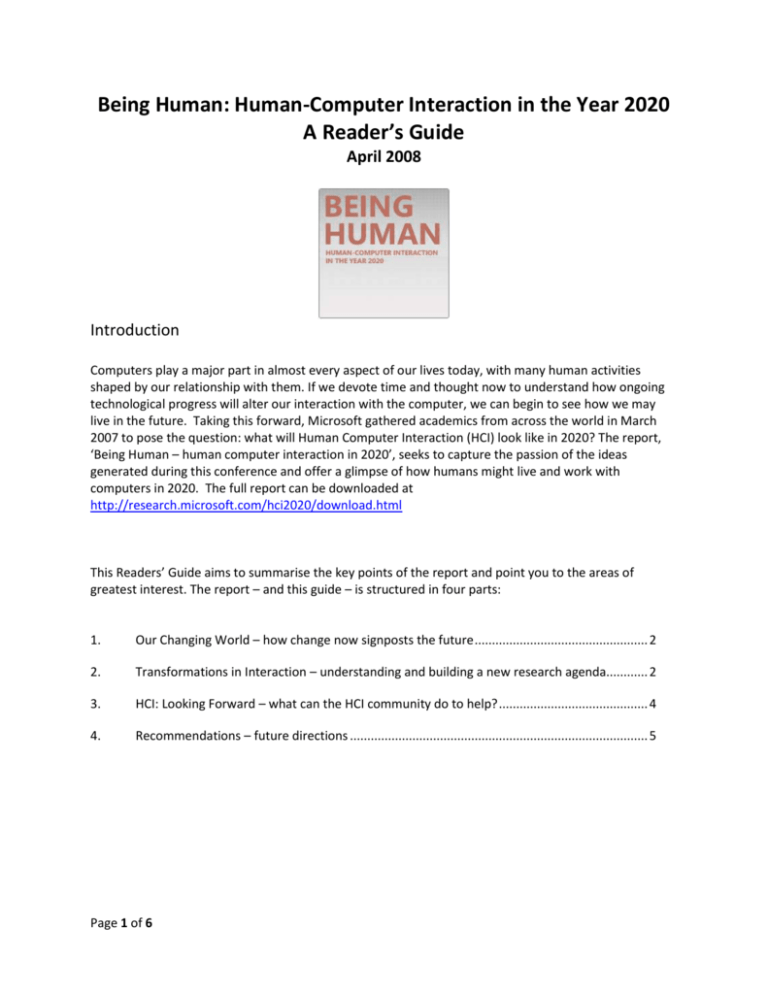
Being Human: Human-Computer Interaction in the Year 2020 A Reader’s Guide April 2008 Introduction Computers play a major part in almost every aspect of our lives today, with many human activities shaped by our relationship with them. If we devote time and thought now to understand how ongoing technological progress will alter our interaction with the computer, we can begin to see how we may live in the future. Taking this forward, Microsoft gathered academics from across the world in March 2007 to pose the question: what will Human Computer Interaction (HCI) look like in 2020? The report, ‘Being Human – human computer interaction in 2020’, seeks to capture the passion of the ideas generated during this conference and offer a glimpse of how humans might live and work with computers in 2020. The full report can be downloaded at http://research.microsoft.com/hci2020/download.html This Readers’ Guide aims to summarise the key points of the report and point you to the areas of greatest interest. The report – and this guide – is structured in four parts: 1. Our Changing World – how change now signposts the future .................................................. 2 2. Transformations in Interaction – understanding and building a new research agenda............ 2 3. HCI: Looking Forward – what can the HCI community do to help? ........................................... 4 4. Recommendations – future directions ...................................................................................... 5 Page 1 of 6 1. Our Changing World – how change now signposts the future Computing, and our relationship with it, is changing fast and encompassing every aspect of our existence: from the way we work to the way we spend our leisure time; from the way we pay our bills to the way the global economy works; from the way we communicate to the way we learn. We need to comprehend and manage key aspects of this change if we are to ensure that it adds to human experience, rather than detracts from it. Interaction with computers is changing now – the forms we are familiar with will soon be obsolete. The keyboard, mouse, pointer and monitor (visual display unit - VDU) are being supplemented by other and often more intuitive forms of interaction and display including stylus-based Tablet computers, speech recognition systems and surfaces that allow us to manipulate on screen objects with our fingertips. Computers embedded within objects – think of the Nintendo Wii –sense and react to the way they are manipulated. The VDU is being superseded by developments in micro-electro-mechanical systems, organic matter and plastic electronics: displays of all sizes will be embedded in all kinds of materials. By 2020, we will still be using paper but will also have new forms of flexible screens that will allow novel forms of content to be delivered and new forms of documents to be deployed. For example, ‘digital paper’ might allow us to create social network magazines that update in real time and clothing capable of performing health diagnostics might capture and even display information in the fabric itself. Robots are becoming a familiar part of everyday life, helping us with domestic chores, dangerous military and emergency applications and even providing companionship in the form of artificial ‘pets’. The ability of computers to make sense of – and take decisions based on – the world around them will significantly enhance their abilities. By 2020 we may be able to interrogate machines and they, in turn, will be able to anticipate what we want from them. This growing role for computers suggests that we must carefully consider our relationship with, and reliance on them. Digital storage, once so expensive, is now affordable with cheap portable memory and vast internetbased storage easily accessible. This is changing our behaviour – we are recording and sharing more aspects of our lives through digital photography, podcasting, blogging and video production via sites like YouTube. Technology is allowing us to manipulate software and produce content in ways that were once the preserve of specialised developers and producers. Paradoxically, as we control more and more digital data, we have less and less control of our ‘digital footprints’. The flipside of increased storage capability is that more data on more aspects of our lives, from mobile phone calls to CCTV footage, can be held without us being aware of it. Simply because we can store data doesn’t mean that we should – raising important privacy concerns in 2020 and providing a key focus of HCI. 2. Transformations in Interaction – understanding and building a new research agenda How we define and think about our relationships with computers is radically changing. How we use them and rely on them is also being transformed. These factors raise many new questions that we have not had to deal with before; some will be within the remit of Human-Computer Interaction to address and others will not. The report identifies five key transformations: Page 2 of 6 The physical boundaries separating us from computers are becoming blurred and may disappear entirely – we are now witnessing the end of interface stability. In one way the interface will become more intimate, embedding our digital devices in our clothing, or in the case of medical monitoring technologies, within our bodies. In another, the interface will seep into the world around us, with computers invisibly embedded in objects and our environment. Networking – computers talking to computers – will tie these diverging interface paths together and enable the broad dissemination of our most intimate information, while channelling mass market information directly to us. We are rapidly taking connectivity, and even hyper-connectivity, for granted. Our interconnected digital environment means that we can link into the world wherever we are, bringing real benefits and real hazards. The old delineation of being at work or at home is disappearing, taking with it the line between professional and private time. Furthermore, the increased capacity to send communications does not mean that we have the capacity to deal with it. With computing so embedded in our lives we are seeing the growth of techno-dependency. As computers take an increasing and yet less obvious role in our lives, it is inevitable this technodependency will grow. As the process accelerates we must also consider the skills that we are giving up to technology. The calculator was widely blamed for a fall in the standard of mental arithmetic – what may we lose as computers become more intelligent and take on greater responsibilities? And we cannot assume that the exploitation of computing will be uniform, either nationally or internationally. As some societies or social groups race forward and embrace the new technologies, others will not, raising the possibility of a world stratified by the digital haves and digital have-nots. These changes are also hastening the end of the ephemeral, whereby activity that was previously thought of as inconsequential and sometimes difficult to track and trace can now be stored digitally. Our shopping habits, movements and even our mistakes are now captured forever – sometimes never to see the light of day, but sometimes exhibited to wider audiences. This, of course, calls for new legislation and new ways of authenticating information to ensure that our potentially beneficial capacity to store more of ourselves doesn’t bring about relentless, invasive and pitiless scrutiny. Today, computers are increasingly offering applications and tools that ordinary users can deploy creatively. This is leading to the growth of creative engagement, acting as a bridge between the physical and digital worlds and augmenting human reasoning. This is having a massive impact on scientific research and discovery, with computer science merging with biology, chemistry, physics and earth sciences to develop tools that can help to address some of the most important questions we face, such as climate change and global pandemics. While capable of delivering great benefit we must also be careful that, as these tools become more complex, we do not lose the ability to know when they malfunction and if they are being properly applied. Without proper consideration and control it is possible that we – both individually and collectively – may no longer be in control of ourselves or the world around us. This potentially places the computer on a collision course with basic human values and concepts such as personal space, society, identity, independence, perception, intelligence and privacy. These are questions HCI needs to consider now. Page 3 of 6 3. HCI: Looking Forward – what can the HCI community do to help? We can see that the explosive growth in computing is a double edged sword, with great potential benefits countered by great potential hazards. As we approach 2020 HCI must evolve from simply designing better computer systems to ensuring that human values, morals and ethics form part of the basic brief. While accepting that such an aim is difficult to achieve, HCI can to help us to understand, shape and control the forces at work in the new digital era. HCI now needs to address ‘human’ centred design, not simply ‘user’ centred design. The report proposes a three-pronged approach to broaden the remit of HCI: I. Include a new stage of conceptual analysis within user-centred research that explicitly addresses higher level concerns. User-centred design to date has followed a four stage Study/Design/Build/Evaluate research model. It is proposed that a fifth component is added which is labelled by the rather simple sounding word – ‘Understand’. As this report outlines, understanding and designing for human values is a more difficult and subtle art than the word ‘understand’ implies. For example, researchers need to understand how human values are expressed in different cultures and social systems and make choices about which values they wish to support. They need to understand how some values contradict other values and how some goals can only be achieved at the expense of others. This stage will require reflective thought and conceptual analysis and will anchor human values, morals and ethics into the design process. Indeed, taking this new perspective will impact all stages of the research model: focusing on human values makes us think differently about the kinds of technologies we design and build, and how they should be evaluated. II. Include disciplines within the HCI process that are equipped to address societal, moral and ethical concerns. The new kind of research model outlined above will call upon experts from other disciplines that might include those from philosophy, psychology, art, literary theory, cultural studies, anthropology, sociology or design. It will also mean talking to stakeholders to discover what kinds of enduring value they believe their users will get from their technology; and what kinds of users and what domains are of interest. III. The creation of a new language to describe HCI in the new era that will enable various parties to understand each other better and describe emerging concepts. A common language, comprising new metaphors, concepts and principles will enable the newly expanded and diverse stakeholder groups involved with HCI to understand each other better, to talk about the emerging issues, and to explore how to steer them in more ‘human’ directions. For example, the way we define an ‘interface’ needs to change since in today’s world the site of interaction can range from within the body to within the built environment or public spaces. Likewise, the definition of a ‘user’ implies conscious, deliberate engagement with computers, which is only one way of interacting with computers. These days, at one extreme, people may interact unwittingly or unwillingly with technology; at the other, they may engage much more closely, even to the point of altering the tools themselves. Page 4 of 6 Case studies on how this is being achieved can be found in the full report. 4. Recommendations – future directions The report makes seven recommendations designed to help HCI better reflect the world within which it works – and help build the one we hope to see on 2020. Recommendation 1: Revisit research and design methods in HCI As HCI has developed the world around it has changed, and the discipline needs to be aware of and incorporate these changes. HCI needs to: Explore new ways of understanding users that complement and expand existing techniques, encompassing other disciplines and cultural traditions. Explore new ways of designing and making, directed towards particular kinds of user experience and the value they derive from it. This must allow for consideration of wider impacts as well as simple human/machine relationships. Reconsider how to evaluate digital technologies, bringing considerations that include leisure, aesthetic and cultural pursuits into the existing work and productivity mix. Recommendation 2: Be specific about the remit of HCI HCI needs to set its boundaries, exploring what it should and should not be involved in. Should the discipline simply facilitate change without regard to its effects, or should it attempt to look at effects at the earliest possible stage? It is clear that HCI needs to consider broader values but cannot continue to absorb other disciplines within its remit. What it can do, with its own boundaries clearly set, is recognise when other disciplines need to become involved and marshal expertise. Recommendation 3: Develop disciplinary techniques that allow HCI to collaborate with other research communities As well as recognising the expertise of other disciplines, HCI needs to consider how to establish effective relationships with them: Disciplinary exchange will be an important requirement – developing the processes necessary to engage with disciplines from very different traditions. Sensitivity to this will need to be taught and cultivated to ensure that HCI researchers understand not only how to engage with others, but when. The HCI community should be articulating good examples of interdisciplinary practice. This is an area where investment in basic research theories and approaches, in the elements of HCI competence and skill, and in the foundations of the philosophy of science are required. Recommendation 4: Teach HCI to the young The report argues that changes in computers and computing have a significant impact on all our lives. Consequently, the study of HCI should be introduced to the young as soon as possible. This goes beyond traditional educational concepts of ‘computer science’ – not just teaching children about how computers and applications work, but about their wider impact. Page 5 of 6 Recommendation 5: More advanced training for future HCI researchers At present there are insufficient numbers of HCI researchers with the breadth of training needed to adequately deal with the multiple issues thrown up by change. HCI must consider how to scale up its educational processes to build generations of researchers that can comfortably engage with the broad set of disciplines, and with people from outside HCI, required as we head towards 2020. Recommendation 6: Engage with government, policy and society Given the enormous impact of the changes we are facing, HCI needs to act in an advisory capacity to governments and policy practitioners, alerting them to potential issues and providing input to legislative and other processes. HCI also needs to extend this engagement further, increasing public awareness so that they too can play a role in shaping the world they want rather than the one they are presented with. Recommendation 7: Offer an inclusive future in 2020 HCI’s role should be to provide balance between the excitement of technological progress and the global impact of further development. The last of the recommendations from this report is that, by 2020, HCI will need to be able to design for and support differences in human value, irrespective of the economic means of those seeking those values. In this way, the future can be different and diverse because people want it to be. Page 6 of 6


